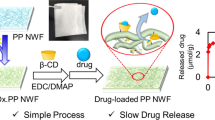Abstract
Radiation-induced graft copolymerization of N-isopropyl acrylamide (NIPAAm) and acrylic acid (AA) mixture was carried out on polypropylene (PP) nonwoven fabric to develop a thermosensitive material. The immobilization and release behaviour of 4-acetamidophenol onto the modified PP nonwoven fabric were studied. The effect of degree of grafting and temperature on the drug release behaviour was investigated. At 32 °C temperature, a small amount of drug was released, and a relatively large amount of drug still remained in the polymer matrix. However, when the release temperature was 40 °C (above the LCST of 37.5 °C), the drug release was greatly accelerated due to temperature induced structure changes of the grafted copolymer chains. It was also observed that the drug release was higher for samples with higher degree of grafting. At higher graft levels, the grafted chains are longer and form the hydrogel network which leads to the more efficient entrapment of the drug within the network on the surface and consequently, more drug tends to diffuse out as compared to the low graft levels. The resulting grafted membranes exhibited temperature-triggered drug release behavior, and have enormous potential for use as drug carriers.







Similar content being viewed by others
References
Qiu Y, Park K (2001) Environment-sensitive hydrogels for drug delivery. Adv Drug Deliv Rev 53:321–339
Schild HG (1992) Poly(N-isopropylacrylamide): experiment, theory and application. Prog Polym Sci 17:163–249
Gupta B, Mishra S, Saxena S (2008) Preparation of thermosensitive membranes by radiation grafting of acrylic acid/N-isopropylacrylamide binary mixture on PET fabric. Radiat Phys Chem 77:553–560
Guy RH, Hadgraft J (2003) Transdermal drug delivery, 2nd edn. Marcel Dekker, New York
Williams A (2003) Transdermal and topical drug delivery. Pharmaceutical Press, London
Prausnitz MR, Mitragotri S, Langer R (2004) Current status and future potential of transdermal drug delivery. Nat Rev Drug Discov 3:115–124
Bronaugh RL, Maibach HI (2005) Percutaneous absorption, 4th edn. Marcel Dekker, New York
Kamath K, Park K (1993) Biodegradable hydrogels in drug delivery. Adv Drug Deliv Rev 11:59–84
Park K, Shalaby WSW, Park H (1993) Biodegradable hydrogels for drug delivery. Technomic, Lancaster
Park K, Park H (1999) Smart hydrogels. In: Salamone JC (ed) Concise polymeric materials encyclopedia. CRC Press, Boca Raton
Jeong B, Gutowska A (2002) Lessons from nature: stimuli-responsive polymers and their biomedical applications. Trends Biotechnol 20:305–311
Kopecek J (2003) Smart and genetically engineered biomaterials and drug delivery systems. Eur J Pharm Sci 20(1):1–16
Kim S, Kim J-H, Jeon O, Kwon IC, Park K (2009) Engineered polymers for advanced drug delivery. Eur J Pharm Biopharm 71:420–430
Martellini F, Mei LHI, Baliño JL, Carenza M (2003) Water and drug transport in radiation-crosslinked poly(2-methoxyethylacrylate-co-dimethylacryl amide) and poly(2-methoxyethylacrylate-co-acrylamide) hydrogels. Radiat Phys Chem 66:155–159
Martellini F, Higa OZ, Takacs E, Safranj A, Yoshida M, Katakai R, Carenza M (1998) Intelligent drug delivery systems obtained by radiation. Radiat Phys Chem 52:295–299
Hoffman AS (1987) Applications of thermally reversible polymers and hydrogels in therapeutics and diagnostics. J Contr Rel 6:297–305
Kost J, Langer R (2001) Responsive polymeric delivery systems. Adv Drug Deliv Rev 46(1–3):125–148
Coughlan DC, Quilty FP, Corrigan OI (2004) Effect of drug physicochemical properties on swelling/deswelling kinetics and pulsatile drug release from thermoresponsive poly(N-isopropylacrylamide) hydrogels. J Control Rel 98(1):97–114
Pişkin E (2004) Molecularly designed water soluble, intelligent, nanosize polymeric carriers. Int J Pharm 277:105–118
Schmaljohann D (2006) Thermo- and pH-responsive polymers in drug delivery. Adv Drug Deliv Rev 58(15):1655–1670
Kaneko Y, Nakamura S, Sakai K, Kikuchi A, Aoyagi T, Sakurai Y, Okano T (1999) Synthesis and swelling-deswelling kinetics of poly(N-isopropylacrylamide) hydrogels grafted with LCST modulated polymers. J Biomater Sci Polym 10:1079–1091
Jeong B, Bae YH, Lee DS, Kim SW (1997) Biodegradable block copolymers as injectable drug-delivery systems. Nature 388:860–862
Hirotsu S (1993) Coexistence of phases and the nature of first-order phase transition in poly(N-isopropylacrylamide) gels. Adv Polym Sci 110:1–26
Irie M (1993) Stimuli-responsive poly(N-isopropylacrylamide). Photo- and chemical-induced phase transitions. Adv Polym Sci 110:49–65
Lim YH, Kim D, Lee DS (1998) Drug releasing characteristics of thermo- and ph-sensitive interpenetrating polymer networks based on poly(N-isopropylacrylamide). J Appl Polym Sci 64(13):2647–2655
Ruiz JC, Alvarez-Lorenzo C, Taboada P, Burillo G, Bucio E, Prijck KD, Nelis HJ, Coenye T, Concheiro A (2008) Polypropylene grafted with smart polymers (PNIPAAm/PAAc) for loading and controlled release of vancomycin. Eur J Pharm Biopharm 70:467–477
Muñoz-Muñoz F, Ruiz J-C, Alvarez-Lorenzo C, Concheiro A, Bucio E (2009) Novel interpenetrating smart polymer networks grafted onto polypropylene by gamma radiation for loading and delivery of vancomycin. Eur Polym J 45:1859–1867
Chapiro A (1962) Radiation chemistry of polymeric systems. Wiley Interscience, New York
Ikram S, Kumari M, Gupta B (2011) Thermosensitive membranes by radiation-induced graft polymerization of N-isopropyl acrylamide/acrylic acid on polypropylene nonwoven fabric. Radiat Phys Chem 80:50–56
Shivaraj A, Selvam RP, Mani TT, Sivakumar T (2010) Design and evaluation of transdermal drug delivery of ketotifen fumarate. Int J Pharm Biomed Res 1(2):42–47
Ansari M, Kazemipour M, Aklamli M (2006) The study of drug permeation through natural membranes. Int J Pharm 327:6–11
Lue SJ, Hsu JJ, Wei TC (2008) Drug permeation modeling through the thermo-sensitive membranes of poly(N-isopropylacrylamide) brushes grafted onto micro-porous films. J Membr Sci 321:146–154
Author information
Authors and Affiliations
Corresponding author
Rights and permissions
About this article
Cite this article
Gupta, B., Kumari, M. & Ikram, S. Drug release studies of N-isopropyl acrylamide/acrylic acid grafted polypropylene nonwoven fabric. J Polym Res 20, 95 (2013). https://doi.org/10.1007/s10965-013-0095-7
Received:
Accepted:
Published:
DOI: https://doi.org/10.1007/s10965-013-0095-7




